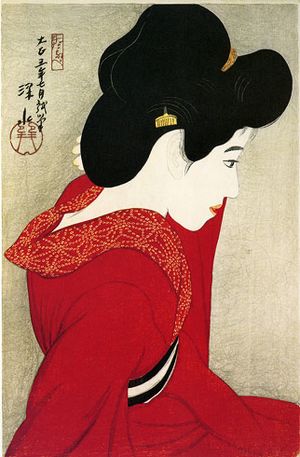Shinsui Itō facts for kids
Quick facts for kids
Itō Shinsui
|
|
|---|---|

Itō Shinsui circa 1954
|
|
| Born |
Itō Hajime
4 February 1898 Tokyo, Japan
|
| Died | 8 May 1972 Tokyo, Japan
|
| Nationality | Japanese |
| Known for | Painter, Woodcut artist |
| Movement | Nihonga, Shin hanga |
| Awards | Living National Treasure Order of the Rising Sun |
Shinsui Itō (Japanese: 伊東 深水, romanized: Itō Shinsui; 1898–1972) was a famous Japanese artist. His real name was Itō Hajime. He was known for his paintings and woodblock prints. He used a special artist name, called a pseudonym, which was Shinsui.
Itō Shinsui was a key artist in the shin-hanga art movement. This movement brought new life to traditional Japanese art. It helped keep old art styles popular when photography was becoming common. He worked during the Taishō period and Shōwa period in Japan.
Contents
The Early Life of Itō Shinsui
Itō Shinsui was born in Fukagawa, a part of Tokyo. His family faced tough times when his father's business failed. Because of this, Itō had to leave elementary school early. He became an apprentice at a printing shop. An apprentice learns a trade by working for someone experienced. This job helped him learn about printing and art.
How Itō Shinsui Started His Art Career
In 1911, Itō became an apprentice to a famous artist named Kaburagi Kiyokata. Kiyokata was the one who gave him the artist name "Shinsui." The very next year, Itō created his first woodblock print. His artistic talent was clear right away. Soon, his paintings were shown in public art shows.
His art was first displayed by the Tatsumi gakai (Southeast Painting Society) in 1912. Later, his works were shown by other groups. These included the Kyodokai (Homeland Society) and the Nihon bijutsuin (Japan Art Institute). His art was also part of the government-sponsored Bunten show. Art critics loved his work, and he quickly became well-known. He won many awards for his early art. He also worked for the Tokyo Nichi Nichi Shimbun newspaper, creating illustrations.
Itō Shinsui and the Shin-hanga Movement
Itō Shinsui was discovered by a publisher named Watanabe Shōzaburō. Watanabe was very important in the shin-hanga movement. He helped many artists, including Itō, become famous. Itō became especially known for his bijin-ga works. These are paintings of beautiful women. He also painted landscapes sometimes.
Before the Mirror: A Famous Work
One of Itō's most important prints is "Before the Mirror." It shows a young woman looking into a mirror that we cannot see. She is wearing a deep red kimono. Itō used natural plant dyes for the red color. He printed the robe many times to make the color rich and deep. He also paid close attention to the background. It had a speckled gray texture that made the red kimono, black hair, and white skin stand out.
Itō's early landscape series, called Eight Views of Lake Biwa, inspired another artist, Kawase Hasui. His early bijin-ga are often seen as his best works. This includes his series Twelve Figures of New Beauties from 1922–1923.
Itō Shinsui's Unique Art Style
Itō opened his own art studio in 1927. His early works looked a lot like traditional ukiyo-e art. But his way of creating prints was new and different. Itō would first paint a "master painting" using watercolors. Then, skilled craftspeople would use this painting to make the actual prints. This made Itō a leader in the shin-hanga movement. Watanabe and Itō worked together for many years. Watanabe sold thousands of Itō's prints around the world. This brought great success to both of them.
Itō Shinsui's Later Life and Honors
During World War II, the Japanese government asked Itō to create art for propaganda. Propaganda art is used to spread ideas or influence people. He traveled to the South Pacific and Japanese-controlled Netherlands East Indies. He made over 3,000 sketches during his travels. After the war, he moved from Tokyo to Komoro in the mountains. Later, in 1949, he moved to Kamakura, Kanagawa.
After the war, Itō became one of Japan's most respected people. He received several important honors. In 1952, his woodblock designing skills were recognized as "intangible cultural properties." This was like being named a Living National Treasure. In 1958, he joined the Japan Art Academy. In 1970, he received the Order of the Rising Sun, a high honor in Japan.
Itō Shinsui's Art on Stamps
One of Itō's artworks, Yubi (meaning "Finger"), was featured on a commemorative postage stamp in 1974. Another work, Fubuki (meaning "Blizzard"), appeared on a Japanese stamp in 1983. These stamps were part of a series about modern Japanese art.
Itō Shinsui passed away in 1972 from cancer. His daughter, Yukiji Asaoka, is a well-known actress and singer. His grave is at the Ryūsō-in temple in Shinagawa, Tokyo.
Major Works by Itō Shinsui
- Eight Views of Lake Biwa – 1917–1918
- Twelve Figures of New Beauties – 1922–1923
- Collection of Modern Beauties – 1929–1931
- Twelve Views of Ōshima – 1937–1938
- Three Views of Mount Fuji – 1938–1939
- Ten Views of Shinano – 1948
- Incense Party (聞香, Monkō) - 1950
His art can be seen in many museums around the world. These include the Virginia Museum of Fine Arts, the Toledo Museum of Art, and the British Museum.
Images for kids



